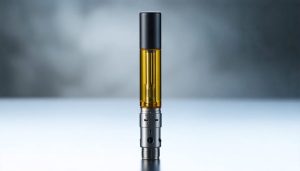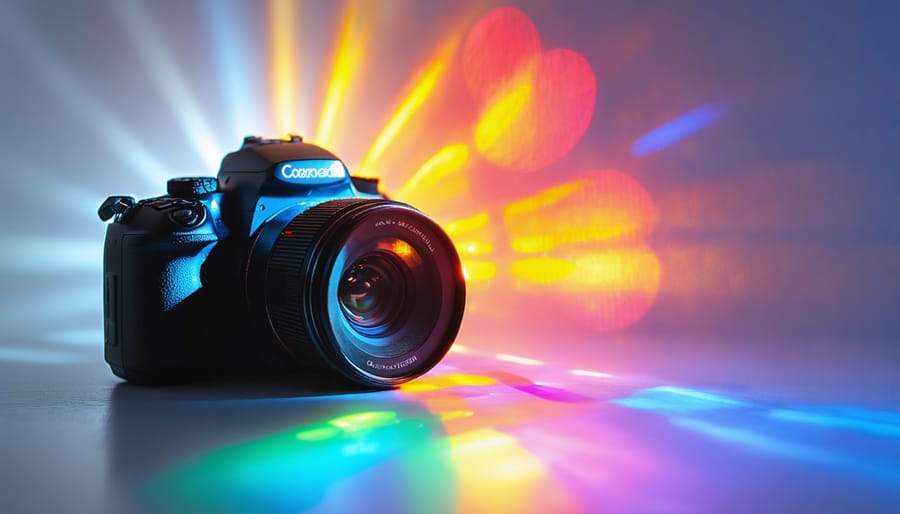
Transform your photography with lens effect filters – the powerful tools that bridge the gap between camera sensor technology and creative vision. These optical elements fundamentally alter how light reaches your sensor, enabling everything from subtle enhancements to dramatic artistic effects that would be impossible to replicate in post-processing.
Whether you’re capturing the silky flow of waterfalls with neutral density filters, enhancing sky drama with polarizers, or adding creative flare with specialty prisms, lens filters represent the perfect fusion of technical precision and artistic expression. Professional photographers have long recognized their value not just as creative tools, but as essential components for protecting expensive glass and managing challenging lighting conditions.
Understanding how these filters interact with your camera’s optical system opens up new possibilities for both technical excellence and creative exploration. From the subtle nuances of UV protection to the transformative power of graduated filters, mastering these tools can elevate your photography from capable to extraordinary.
The Science Behind Lens Filters and Sensors
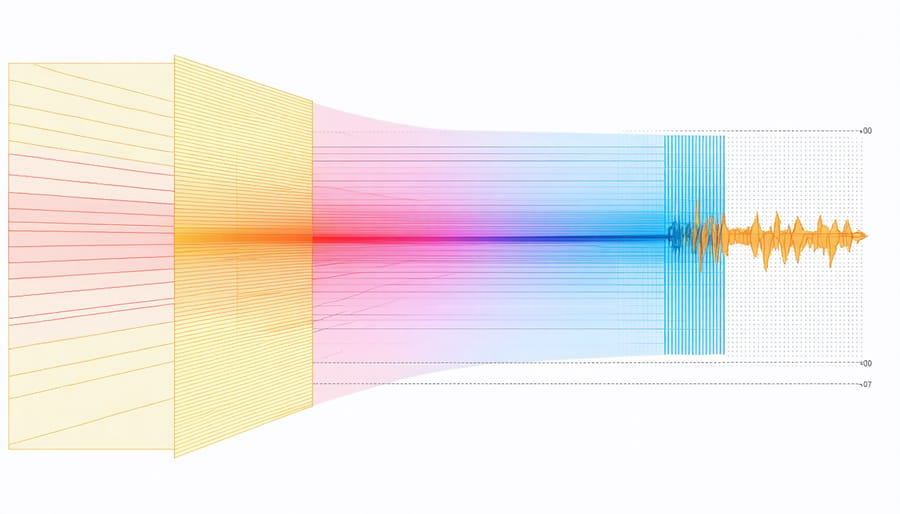
Light Transmission and Sensor Response
Modern digital sensors respond differently to light than traditional film, making the interaction between lens filters and sensors particularly important. When light passes through a filter, different wavelengths are either transmitted or blocked before reaching the sensor, affecting both exposure and color rendition.
Digital sensors are most sensitive to green light, followed by red, and least sensitive to blue wavelengths. This varied sensitivity means that filters can have unexpected effects on your final image. For instance, a warming filter might require less compensation on a digital camera than it did with film, as sensors naturally tend to be more responsive to warmer tones.
Understanding your camera’s specific sensor characteristics becomes crucial when using lens effect filters. Modern sensors typically have a built-in UV/IR cut filter, which means additional UV filters might have less noticeable impact than they did in film photography. However, neutral density and polarizing filters remain equally effective across both mediums.
When stacking multiple filters, it’s important to consider that each layer of glass reduces light transmission and potentially introduces unwanted reflections. This effect becomes more pronounced with high-resolution sensors that can reveal even subtle degradation in image quality.
Filter Quality Impact on Resolution
The quality of your lens filters can significantly impact how well your camera’s sensor captures detail, much like how lens quality affects sensor performance. Using cheap filters often introduces unwanted artifacts, such as reduced sharpness, color casting, or ghosting effects that can degrade image quality. Think of it like putting a dirty window in front of your camera – even the most advanced sensor can’t see clearly through poor-quality glass.
High-quality filters use precision-ground optical glass with advanced coatings that maintain image clarity while adding the desired effect. They typically feature multi-coating technology that reduces reflections and maintains light transmission, ensuring your sensor receives the cleanest possible image. This becomes especially crucial when shooting in challenging conditions like bright sunlight or when capturing fine details in landscape photography.
Budget-friendly filters might seem attractive initially, but they can effectively downgrade your expensive camera and lens combination to a lower-performing system. When investing in filters, it’s worth remembering that they’re an integral part of your optical system, not just accessories.
Common Lens Filters and Their Sensor Effects
UV and Protection Filters
UV and protection filters serve as your camera sensor’s first line of defense while having minimal impact on image quality differences. These clear filters block ultraviolet light and create a protective barrier between your valuable lens and potential hazards like dust, moisture, and accidental bumps.
While some photographers debate their necessity, quality UV filters can be invaluable when shooting in challenging environments. Think beach photography with sand in the air, or hiking through misty conditions where lens protection becomes crucial. The key is investing in high-quality filters that feature multi-coating technology to minimize ghosting and flare.
Modern digital sensors already have UV protection built-in, so the primary benefit of these filters today is physical protection. When choosing a UV filter, opt for reputable brands that use premium glass and coatings. Budget filters can introduce unwanted reflections and slightly reduce contrast, so consider this an investment in your gear’s longevity rather than a casual add-on.
Remember to keep your UV filter clean and check periodically for scratches or damage that might affect your images. In situations where absolute optical purity is crucial, such as night photography, you can always remove the filter temporarily.
Polarizing Filters
Polarizing filters work their magic by selectively filtering light waves based on their orientation, dramatically affecting how your camera’s sensor captures the scene. When light bounces off non-metallic surfaces like water or glass, it becomes polarized, often creating unwanted glare and reducing color saturation. A polarizing filter can eliminate these reflections, allowing your sensor to capture richer, more vibrant colors and deeper contrast.
By rotating the filter, you can control exactly how much polarized light reaches your sensor. At its optimal position, a polarizing filter can cut through atmospheric haze, deepen blue skies, and make clouds pop with stunning definition. It’s particularly effective when shooting at right angles to the sun, where the polarization effect is strongest.
However, it’s worth noting that polarizing filters typically reduce light transmission by about 1-2 stops. This means your camera’s sensor receives less light overall, which might require adjusting your exposure settings. While this light loss might seem like a drawback, many photographers consider it a worthwhile trade-off for the enhanced color saturation and contrast that simply can’t be replicated in post-processing.
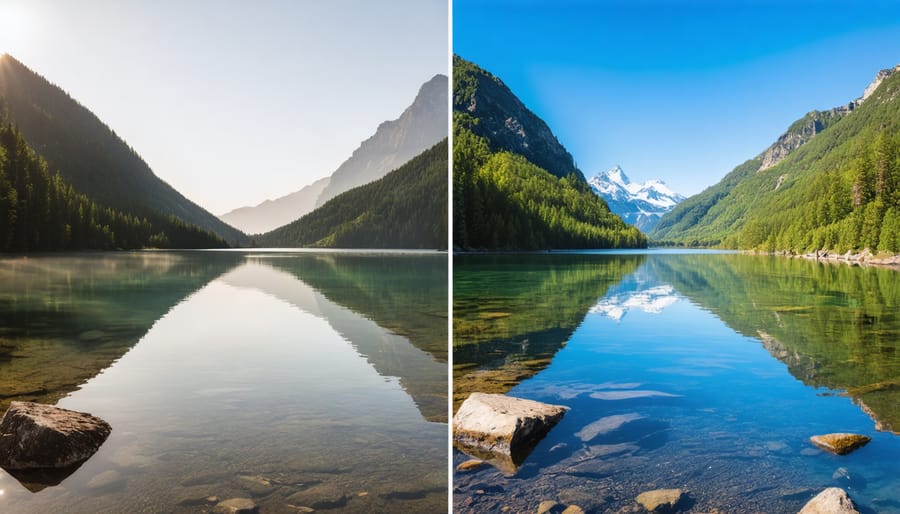
ND Filters
Neutral Density (ND) filters are like sunglasses for your camera, reducing the amount of light that reaches your sensor without affecting color. These essential tools enable photographers to control exposure in challenging lighting conditions, particularly when you need to use slower shutter speeds or wider apertures in bright environments.
Available in various strengths (typically marked as ND2, ND4, ND8, and so on), these filters can reduce light by anywhere from one to ten stops or more. For instance, a 10-stop ND filter allows you to transform a 1/1000 second exposure into a full second, opening up creative possibilities for long-exposure photography.
Beyond exposure control, ND filters help manage dynamic range by balancing extreme brightness differences in a scene. Think of shooting waterfalls on a sunny day – an ND filter lets you capture that silky-smooth water effect while maintaining proper exposure in the highlights. They’re particularly valuable for landscape photographers who want to create motion blur in clouds or water, and for videographers needing to maintain specific shutter speeds while achieving shallow depth of field in bright conditions.
When selecting an ND filter, consider both fixed and variable options, keeping in mind that higher-quality filters will minimize color cast and maintain image sharpness.
Color Correction Filters
Color correction filters play a vital role in achieving accurate color representation and maintaining proper white balance in your photography. These filters help compensate for various lighting conditions that might otherwise create unwanted color casts in your images. For instance, a warming filter can help neutralize the cool, bluish tints often present in shady conditions, while cooling filters can balance out the warm, orange glow of tungsten lighting.
One of the most commonly used color correction filters is the 81-series warming filter, which subtly enhances skin tones and adds warmth to landscapes, particularly during the “blue hour” just before sunset. The 82-series cooling filters, conversely, help maintain color accuracy when shooting under artificial lighting conditions.
While digital cameras offer white balance adjustment features, color correction filters can still provide unique benefits. They can help reduce the workload in post-processing and ensure more accurate colors straight out of camera. Additionally, these filters can be particularly valuable when shooting film, where in-camera white balance adjustment isn’t an option.
When selecting color correction filters, consider the specific lighting challenges you commonly encounter and choose filters that complement your shooting style and subjects.
Real-World Performance Considerations
Filter Stacking Effects
When stacking multiple filters, photographers need to be aware of several important effects on their camera’s sensor performance. Each additional filter reduces light transmission, typically by 1-2% per filter, which can impact exposure settings and potentially force you to shoot at higher ISOs. This light loss becomes more noticeable when stacking three or more filters.
Multiple filters can also introduce unwanted reflections between the filter surfaces, potentially creating ghosting or flare in your images. This effect is particularly noticeable when shooting bright light sources or in high-contrast scenes. Quality multi-coated filters help minimize these issues, but they can’t eliminate them entirely when stacking.
Physical vignetting becomes another concern with filter stacking, especially when using wide-angle lenses. The combined thickness of multiple filters can create visible darkening at the image corners. To avoid this, consider using thin-profile filters when you need to stack, or limit stacking to longer focal lengths where vignetting is less pronounced.
For optimal image quality, it’s generally recommended to use no more than two filters simultaneously. If you need multiple effects, consider investing in hybrid filters that combine functions, such as a polarizer-ND combination.
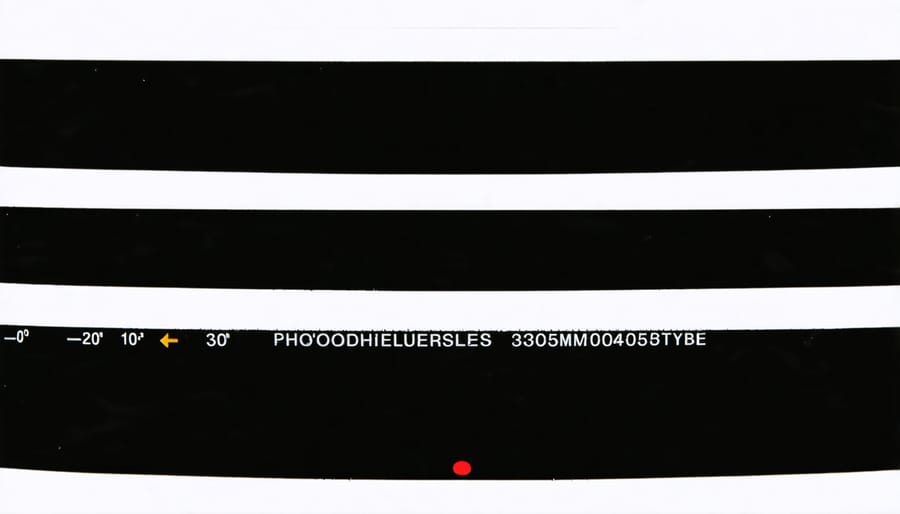
Weather and Environmental Factors
Weather conditions and environmental factors can significantly impact how lens effect filters interact with your camera’s sensor. In humid conditions, moisture can accumulate between the filter and lens, potentially causing unwanted diffraction or ghosting effects. Cold weather might cause the filter glass to contract slightly, while extreme heat could lead to minimal expansion – though these effects are usually negligible with high-quality filters.
Shooting in dusty environments requires extra attention, as particles can settle on the filter surface and create unexpected light scattering. This is particularly noticeable when shooting directly into light sources. UV filters become especially valuable in high-altitude locations where ultraviolet radiation is stronger, helping to reduce haziness in your images.
Rain and water droplets on filters can create interesting creative effects, but they may also interfere with your sensor’s ability to accurately meter the scene. When shooting in challenging weather conditions, consider using filters with high-quality coating treatments that repel water and resist fingerprints. These coatings also help maintain consistent performance across different temperature ranges and humidity levels.
Remember to regularly clean your filters and check for condensation when moving between different temperature environments, as this can temporarily affect the filter-sensor relationship.
Digital vs. Physical Filters
In today’s digital age, photographers often debate whether to use physical lens filters or rely on post-processing effects. Both approaches have their merits, and understanding their differences can help you make the right choice for your shooting situation.
Physical filters offer real-time results and interact with light before it reaches your sensor. This means what you see through your viewfinder is exactly what you’ll capture, making composition more intuitive. They’re particularly valuable for effects that can’t be perfectly replicated digitally, like polarization or true neutral density gradients.
Digital filters, applied either in-camera or during post-processing, offer incredible flexibility. You can adjust their intensity after the shot, remove them entirely, or apply multiple effects without stacking physical filters. They don’t reduce image quality through additional glass elements and won’t gather dust or scratches over time.
However, digital filters can’t replicate all physical effects perfectly. For instance, a circular polarizer’s effect on reflections and sky polarization is nearly impossible to achieve through post-processing. Similarly, long-exposure effects created with ND filters must be captured in-camera.
The best approach often combines both methods. Use physical filters for effects that must be captured in-camera, like polarization or long exposures, while relying on digital filters for adjustments that can be effectively achieved in post-processing, such as color warming or subtle vignetting.
Choosing the Right Filter for Your Sensor
When selecting filters for your camera, it’s crucial to consider how they interact with specific sensor types. Modern digital sensors respond differently to filtered light compared to traditional film, and understanding these differences can significantly impact your final images.
For full-frame sensors, standard thickness filters typically work well, but you’ll want to be particularly careful with wide-angle lenses to avoid vignetting. APS-C sensors generally benefit from slim or ultra-slim filter designs, especially when using wide-angle lenses, as the crop factor can make vignetting more pronounced.
Quality matters more than ever with high-resolution sensors. Lower-quality filters can introduce subtle artifacts that become noticeable when pixel-peeping, particularly with sensors above 24 megapixels. Look for filters with multi-coating technology that reduces reflections and maintains optimal light transmission.
Color cast is another important consideration. Some cheaper filters can introduce unwanted color shifts that are particularly noticeable with today’s sensitive sensors. invest in filters that maintain neutral color transmission or intentionally warm/cool the image according to your creative vision.
Remember that stack height (the combined thickness of multiple filters) can affect autofocus accuracy on some camera systems. If you frequently use multiple filters, consider investing in a high-quality thin filter system that allows for minimal separation between elements.
Lens effect filters offer photographers powerful tools to enhance their creative vision and overcome technical challenges in various shooting situations. Throughout this guide, we’ve explored how these filters can transform your photography, from subtle improvements in image quality to dramatic artistic effects.
Remember that while filters can be invaluable additions to your kit, they should be chosen thoughtfully based on your specific needs. Start with essential filters like UV and polarizing filters, which offer both protection and versatile functionality. As you grow more comfortable, experiment with neutral density and specialty effect filters to expand your creative possibilities.
When selecting filters, prioritize quality over quantity. Invest in high-grade glass filters from reputable manufacturers to maintain your lens’s optical performance. Consider purchasing filters in the largest thread size you need, along with step-up rings, to maximize compatibility across your lens collection.
For beginners, we recommend starting with a basic filter kit including a UV filter for protection, a circular polarizer for managing reflections and enhancing colors, and perhaps a neutral density filter for long exposure work. More advanced photographers might explore gradient filters, specialty effects, or stacking techniques to achieve their creative vision.
Remember to maintain your filters properly, keeping them clean and stored safely to ensure consistent performance and longevity. With proper care and thoughtful application, lens effect filters can become indispensable tools in your photographic journey.









